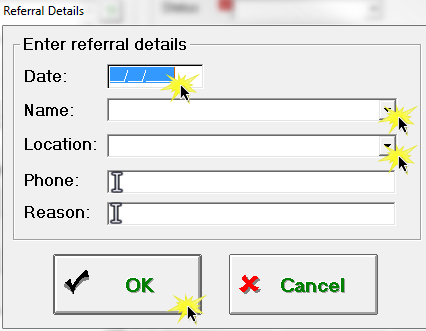Objective 7: Medication Reconciliation
| What the objective requires | What that means for you | Are you excluded from having to do this? | ||
|---|---|---|---|---|
| The EP who receives a patient from another setting of care or provider of care or believes an encounter is relevant should perform medication reconciliation. |
You must perform medication reconciliation for more than 50% of transitions of care in which the patient is transitioned into your care. |
If you did not receive any patients (transitions of care) from another provider's care to your care during your EHR reporting period, you can claim an exclusion for this measure. |
You must record the date that a patient transitions into your care in the Front Desk application so that your system can recognize and count your reconciliation activity during your reporting period toward your compliance with this measure.
- Open the Front Desk application and click Patient Management.
- Select a patient from the Active Patients list and click Pat. Info.
- In the General tab, select Another Provider from the Referred by drop-down menu.
- Click Details.

- The software will open the Referral Details dialog box. Enter the date the patient was referred into your care.
- Select the name and location of the referring provider and enter their phone number and the reason for the referral. Click OK.

- Close the Front Desk application.
NOTE:
The date the patient was referred into your care must fall within your Stage II reporting period to count toward your compliance. This is the trigger for your software to include this patient in the denominator of the compliance percentage in the Medication Reconciliation widget in your EHR Dashboard. The software will display this patient in the list patients who transferred into your care and for whom you must perform medication reconciliation.
Reconcile Medications using CTRx
- Compare the list of medications the patient gave you with the list of medications their original provider had on file for the patient, and clarify any discrepancies with the patient.
- Enter the corrected medication list into CTRx.
- In the EHR Wizard, indicate that the patient’s medications were reconciled. (Note: If Medication Reconciliation appears excluded, include it in the Dashboard.)
Reconcile Medications using MaxMD
- Open the Patients application from the CT Launcher.
- Click Reconciliation.

- The software will open a CCDA Reconciliation dialog box. Click Reconcile in a row that lists a patient for whom you need to perform medication reconciliation.

- The software will open a Reconciliation window displaying the medication information sent by the participating provider. Select the information listed in the panes on the left and click the right-facing green arrow. Click Reconcile.

- The software will open a dialog box. Click Continue.
- Close the Patients application. When you click Calculate in the EHR Dashboard application, the software will reflect your progress toward Objective 7 compliance on the EHR dashboard under Medication Reconciliation.
Medication Reconciliation – The process of identifying the most accurate list of all medications that the patient is taking, including name, dosage, frequency, and route, by comparing the medical record to an external list of medications obtained from a patient, hospital or other provider.
Transition of Care - The movement of a patient from one setting of care (for example, a hospital, ambulatory primary care practice, ambulatory specialty care practice, long-term care, home health, rehabilitation facility) to another. Referral - Cases where one provider refers a patient to another, but the referring provider maintains his or her care of the patient as well.
Denominator for Transitions of Care and Referrals: The denominator includes transitions of care and referrals (as finalized in the Stage 2 rule where the definition of transitions of care includes: "When the EP is the recipient of the transition or referral, first encounters with a new patient and encounters with existing patients where a summary of care record (of any type) is provided to the receiving EP"(77 FR 53984).
Use this equation to determine whether you meet the attestation requirement.
| Numerator | ÷ | Denominator | = | Result |
|---|---|---|---|---|
| The number of transitions of care in the denominator where medication reconciliation was performed. | Number of transitions of care during the EHR reporting period for which the EP was the receiving party of the transition. |
The resulting percentage must be more than 50% in order for an EP to meet this measure. |
You can claim an exclusion if you are an EP who:
- Was not the recipient of any transitions of care during the EHR reporting period.
Only patients whose records are maintained using certified EHR technology must be included in the denominator for transitions of care.
In the case of reconciliation following transition of care, the receiving EP should conduct the medication reconciliation.
The electronic exchange of information is not a requirement for medication reconciliation.
The measure of this objective does not dictate what information must be included in medication reconciliation. Information included in the process of medication reconciliation is appropriately determined by the provider and patient.
We define “new patient” as a patient never before seen by the provider. A provider may use an expanded definition of “new patient” for the denominator that includes a greater number of patients for whom the action may be relevant within their practice, such as inclusion of patients not seen in 2 years.
In order to meet this objective and measure, an EP must use the capabilities and standards of CEHRT at 45 CFR 170.314 (b)(4).
